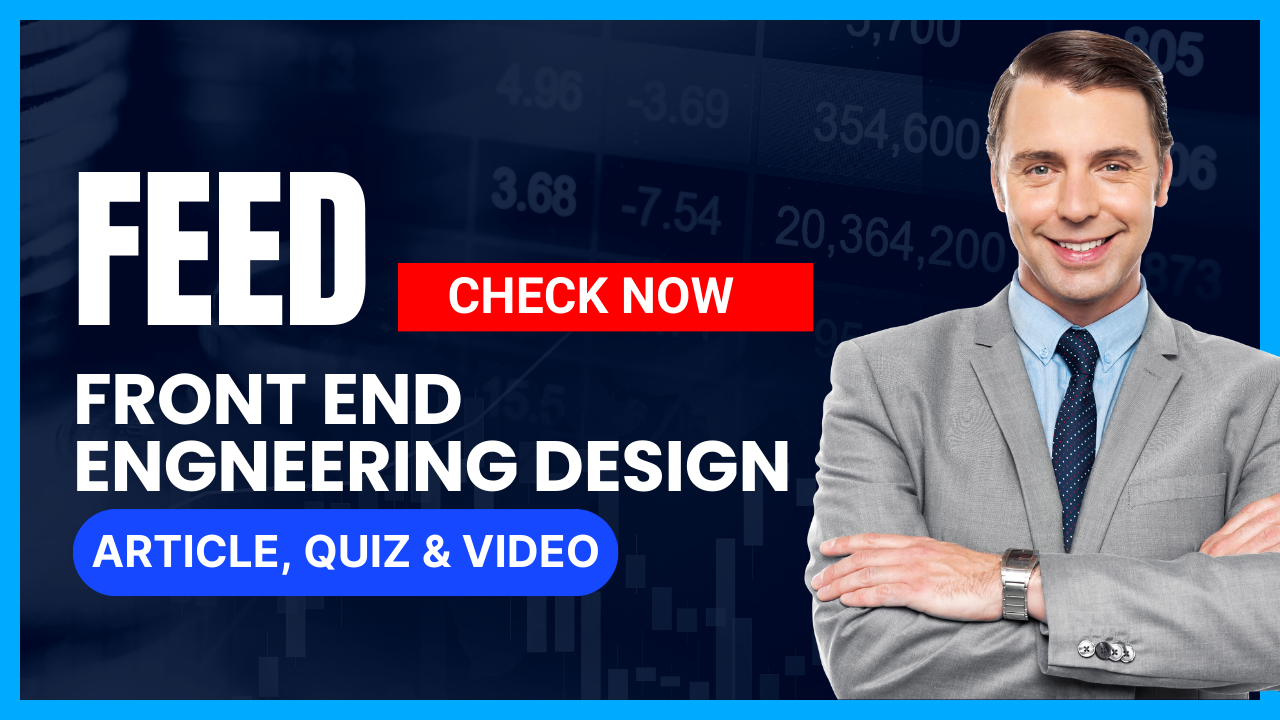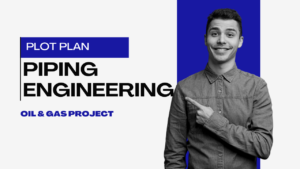Front End Engineering Design, commonly abbreviated as FEED, stands as a foundational engineering strategy undertaken prior to detailed engineering, procurement, and construction phases. It represents a crucial engineering stage that wields the power to shape project expenditure and meticulously blueprint a project before the submission of bids. Comprehensive studies have established that FEED typically constitutes around 2% of the overall project cost; however, adeptly executed FEED initiatives hold the potential to curtail costs by as much as 30% throughout the design and implementation stages. Often referred to as Front End Loading or Front End Engineering, this phase is an essential precursor to project advancement.
Table of Contents
Don’t miss the Complete Course on Piping Engineering: Check Now
By EPCLand.com
The Essence of Front End Engineering Design
FEED finds its significance in its role as an anticipatory measure that precedes the intricate project stages. This preparatory phase not only facilitates thorough cost management but also serves as the crucible for extensive project planning before project proposals are put forth. By conducting in-depth analyses and forecasting, FEED becomes a linchpin for streamlined project execution.
Unveiling the Purpose of FEED
At its core, Front End Engineering Design, or FEED, endeavors to achieve several key objectives:
- Defining Technical and Project-specific Requirements: One of the primary aims of FEED is to delineate the technical intricacies and project-specific prerequisites, laying a clear foundation for project scope.
- Crafting the Project Approach and Design Basis: FEED serves as the canvas upon which the project’s approach and design rationale are meticulously sketched, forming a robust basis for the entire system.
- Developing an Accurate Project Cost Estimate: FEED is instrumental in generating a well-informed project cost estimate, a cornerstone for budget authorization and financial planning.
- Mitigating Project Risks: By identifying and addressing potential risks early, FEED significantly reduces the vulnerability of the project to unforeseen challenges.
- Estimating Project Duration and Schedule: FEED provides a framework for gauging the projected timeline and schedule during the more detailed design phase.
Pioneering Engineering Documents in FEED
The Front End Engineering Design phase produces an array of preliminary engineering documents that form the bedrock for subsequent detailed engineering design. Collectively known as the “FEED Package,” these documents serve as the compass that guides the project’s evolution. A robust FEED package takes into account all project-specific requisites of the client, thus mitigating the need for substantial alterations during project execution. This package holds pivotal importance as it governs the design execution of EPC or EPCM projects.
Duration of FEED Projects: Navigating Fast-Track Engineering
Front End Engineering Design (FEED) projects are renowned for their agile and fast-paced nature within the realm of engineering endeavors. When considering the temporal aspect of a front-end engineering design project, it becomes evident that these projects operate on a swift trajectory. Typically, the time frame allocated for a front-end engineering design project spans less than a year. This concise timeframe underscores the need for not only expertise but also precision in executing FEED projects, all while upholding stringent safety standards.
Executing FEED projects within such a limited time span demands a comprehensive understanding of the engineering intricacies and a streamlined approach. The urgency of the timeline necessitates a cohesive collaboration between various stakeholders involved in the project. This collaboration involves a trifecta of communication: Project Owners, Operators (Clients), and the specialized Engineering Consultants. This interplay of communication ensures that all the intricacies and prerequisites outlined in the FEED package are addressed effectively and efficiently.
Classification of FEED Projects: Tailoring Detail to Design
The classification of FEED projects is intricately tied to the degree of detail required during the front-end engineering design phases. This classification is pivotal as it determines the extent to which the nuances of a project are explored and defined before advancing into the next phases of implementation. Depending on these requirements, FEED projects can be conveniently categorized into three distinct groups:
- Basic FEED: This category encapsulates projects where the primary focus is on establishing the fundamental framework of the project. While the intricacies are acknowledged, the emphasis is on providing a solid foundation for subsequent stages.
- Intermediate FEED: Projects falling under this category delve deeper into the engineering intricacies. Here, the goal is to strike a balance between establishing the foundation and providing more comprehensive design details.
- Extended FEED: This category represents projects where an exhaustive level of detail is sought during the front-end engineering design phases. Here, the engineering analysis, project blueprinting, and design intricacies are explored extensively, laying a robust groundwork for further implementation.
The classification of FEED projects based on their detail requirement serves as a strategic maneuver to align the project’s scope with its intricacies. It ensures that the level of detail matches the project’s magnitude and complexity, setting the stage for seamless progression into subsequent phases.
In essence, the duration of FEED projects and their classification based on detail requirement collectively underscore the dynamic and meticulous nature of front-end engineering design. This approach, driven by efficiency and precision, forms the bedrock for successful project execution and realization.
FEED’s Contribution to Project Success
FEED, beyond its preliminary nature, plays a pivotal role in ensuring project triumph. Its contributions resonate throughout the project:
- Cost Management: The accurate cost estimation fostered by FEED minimizes the risk of financial overruns, enabling stringent cost control.
- Adherence to Schedules: By identifying potential roadblocks in advance, FEED reduces the likelihood of schedule deviations, thereby ensuring smoother progress.
- Risk Alleviation: The meticulous risk assessment conducted during FEED empowers project teams to pre-emptively address challenges, preventing them from escalating.
- Stakeholder Alignment: FEED promotes a unified understanding of project goals among stakeholders, fostering seamless collaboration.
Front End Engineering Design Deliverables: Tailoring Engineering Excellence
Drawing upon Piping Engineering as the focal point, the deliverables within the domain of front-end engineering design for a FEED project manifest as follows:
Basic FEED Deliverables:
- Overall Plot Plan
- PMS or Piping Material Specification
- Tie-in Details
Intermediate FEED Deliverables:
In addition to the aforementioned Basic FEED deliverables:
- Piping Purchase Specification
- Piping Layout Design Basis
- Piping Stress Analysis Design Basis
- Interface Register
- Demolition Scope Details/Drawings
- Conceptual Notes on the Overall Plot Plan
- Assumptions Underpinning the Design Basis
Extended FEED Deliverables:
Encompassing Basic and Intermediate FEED deliverables, the Extended FEED phase extends to include:
- Unit Plot Plan
- Equipment Layout
- Pipe-Rack Sections
- Pipe Thickness Calculation
- Valve Datasheets
- Preliminary Stress Analysis for Pipe Routing/Civil Loading
- Piping Support Standard
- Special Item List
- Piping Standard Assembly Drawings
- Piping Scope of Work
- Preliminary 3D Model
FEED Engineering Deliverables in Process Engineering: Crafting Operational Ingenuity
In tandem with the process engineering team, the quintessential FEED engineering deliverables unfold as follows:
- Process Flow Diagrams (PFD) and Preliminary P&ID Generation
- Process Modeling
- Creation of Technical Specifications and Design Basis
- Specification and Sizing of Equipment
- Sizing and Selection of Safety Devices
- Comprehensive Hydraulic Calculations
- Thorough Pipe Sizing
In essence, the spectrum of front-end engineering design deliverables, within the context of Piping Engineering and Process Engineering, converges to epitomize meticulous project preparation. These deliverables cascade from foundational plans to intricate specifications, each embodying a pivotal piece in the puzzle of project execution excellence.
Front End Engineering Design Deliverables Across Disciplines: Crafting Project Excellence
Front End Engineering Design (FEED) ushers in a realm of discipline-specific deliverables that lay the cornerstone for successful project execution. Within various engineering disciplines, these deliverables are meticulously crafted to ensure comprehensive planning and informed decision-making.
Mechanical Discipline Deliverables:
- Equipment List and Specifications: Encompassing machinery and mechanical components, these specifications outline the precise requirements for each equipment unit.
- Piping and Instrumentation Diagrams (P&IDs): These diagrams depict the interconnectivity of piping systems and the instrumentation associated with them.
- Equipment Layouts: Detailed layouts visually map the arrangement of equipment within the plant or facility, optimizing space utilization and functionality.
- Material Selection and Specifications: Defining the materials to be used for construction, this deliverable ensures compatibility with the project’s operational requirements.
- Pressure Vessel and Heat Exchanger Specifications: These specifications provide engineering details for the design, fabrication, and operation of pressure vessels and heat exchangers.
Electrical Discipline Deliverables:
- Single Line Diagrams (SLDs): Illustrating the electrical distribution system, SLDs show the flow of power through various components.
- Cable and Conduit Layouts: These layouts map out the routing and arrangement of cables and conduits, ensuring efficient distribution and organization.
- Electrical Equipment Specifications: Detailed specifications outline the technical requirements for electrical equipment, ensuring seamless integration.
- Lighting Design: This involves designing the lighting system to meet functional and safety requirements while minimizing energy consumption.
- Load Calculations: Calculations determine the electrical load demand, aiding in the design of power distribution systems.
Instrumentation Discipline Deliverables:
- Instrument Index: A comprehensive list of all instruments used in the project, detailing their specifications and intended functions.
- Instrumentation Loop Diagrams: Diagrams depicting the connection and interaction between instruments, control elements, and process equipment.
- Control Philosophy: Outlining the overall control strategy, this document guides the design and implementation of process control systems.
- Instrument Data Sheets: These sheets provide detailed specifications for each instrument, including accuracy, range, installation requirements, etc.
- Instrument Location Drawings: Visual representations of instrument placement within the plant or facility, ensuring accuracy during installation.
Civil Discipline Deliverables:
- Site Layout Plans: Depicting the arrangement of structures, utilities, and access points, these plans optimize site utilization.
- Foundation Design: Detailed designs for foundations ensure the stability and integrity of structures, considering soil conditions and loads.
- Structural Drawings: These drawings detail the design and arrangement of structural components, ensuring structural integrity.
- Grading and Drainage Plans: Addressing surface drainage and elevation changes, these plans manage stormwater and prevent flooding.
- Road and Access Design: Designing access roads and pathways for efficient movement within the site, considering traffic flow and safety.
Each discipline’s FEED deliverables contribute to the comprehensive planning and execution of a project, ensuring that every facet is addressed with precision and expertise. Collaborative effort among these disciplines forms the bedrock for a successful project lifecycle.
Prerequisites for a FEED Project: Essential Foundations
To embark on a Front End Engineering Design (FEED) project, several key inputs must be in place. These foundational elements serve as the building blocks for a successful FEED project:
- FEED Engineering Scope of Work: A well-defined scope outlines the boundaries and expectations of the FEED project, setting the stage for its execution.
- Feasibility Study Report: This report assesses the viability of the project, considering technical, financial, and operational aspects, guiding the project’s feasibility during the FEED phase.
- Location and Site Details: Precise information about the site where the plant or facility will be established is imperative. This encompasses geographical, geological, and logistical considerations.
- List of Applicable Codes and Standards: A comprehensive compilation of relevant industry codes and standards ensures compliance with established norms and regulations.
- Customer’s Technical Practices: Understanding the specific technical preferences and practices of the customer aids in tailoring the FEED project to align with their requirements.
In its entirety, the FEED phase stands as a pivotal and strategic planning tool, orchestrating the course of project development.
Sequel to Front-End Engineering Design: Unveiling the Next Chapter
Front-End Engineering Design (FEED) holds the mantle of identifying technical prerequisites, potential risks, and estimated costs for a proposed project. Upon receiving the green signal for project execution, the baton is passed to Detailed Design Engineering (often referred to as Detailed Engineering or DD engineering). In this phase, intricate and comprehensive project design and construction work takes center stage. Hence, Detailed Engineering follows the culmination of FEED engineering.
Decoding the Essence of a FEED Study
The Front-End Engineering and Design process constitutes a paramount pre-project planning endeavor. A typical FEED study entails the production of technical documents, validation of product specifications, clarification of the project’s scope, and a preliminary estimation of the project’s financial implications. This study is an indispensable compass that guides projects towards a well-informed path.
Unveiling Pre-FEED Engineering: Setting the Stage
Pre-FEED Engineering serves as a preliminary stride, often undertaken before delving into the rudiments of basic engineering. While optional, this project phase is instrumental in confirming the project’s technical and economic feasibility. Depending on the project’s nature and the inherent uncertainties, Pre-FEED work might merge with conceptual work and studies, shaping the project’s foundation.
The Genesis of Project: The Front End
The initial phase of a project’s lifecycle is known as the front end. It’s during this phase that the concept of the project is conceived. The front-end phase extends until the final verdict is reached: whether to proceed with the project or to halt its initiation.
Distinguishing FEED from Detailed Engineering: A Comparative Analysis
FEED and Detailed Engineering stand as distinct terms within a project’s life cycle. While FEED focuses on establishing project costing and fundamentals, Detailed Engineering delves into intricate project work, encompassing design and construction. Major disparities between these two stages are succinctly summarized in the following table:
| Aspect | FEED Engineering | Detailed Engineering |
|---|---|---|
| Nature | Basic engineering phase | Detailed project work |
| Goal | Project costing and fundamentals | In-depth design and construction |
| Time Requirement | Preliminary and relatively short | Extended and thorough |
| Manpower and Cost Requirement | Less manpower and cost | Higher manpower and cost |
| Project Stage | Often the initiation phase | Follows FEED phase |
In essence, FEED and Detailed Engineering each play vital roles in the project’s progression, one establishing the groundwork, the other transforming plans into tangible reality.
FAQs
Q1: What is the primary purpose of Front End Engineering Design (FEED)?
A1: The primary purpose of FEED is to define technical and project-specific requirements, establish the project’s approach and design basis, estimate project costs, mitigate risks, and assess project duration.
Q2: How does FEED contribute to cost reduction?
A2: While FEED accounts for approximately 2% of project costs, well-executed FEED initiatives can curtail overall costs by up to 30% during the design and execution stages.
Q3: What documents are produced during the FEED phase?
A3: The FEED phase yields an assortment of preliminary engineering documents that collectively form the “FEED Package,” serving as the bedrock for detailed engineering design.
Q4: What role does the FEED package play in project execution?
A4: The FEED package, comprising essential project-specific requisites, guides the design execution of EPC or EPCM projects, minimizing the need for significant changes.
Q5: What is the timeline for a FEED project?
A5: FEED projects are characterized by their fast-track nature, often taking less than a year for completion. Effective communication between project stakeholders and engineering consultants is vital for comprehensive FEED package development.
Conclusion
Front End Engineering Design, or FEED, emerges as a cornerstone engineering approach that sets the stage for successful project realization. By crafting a meticulous blueprint, estimating costs, and addressing potential risks, FEED proactively paves the way for smoother execution. Its role transcends the preliminary phase—it is a strategic instrument that shapes the trajectory of projects, facilitating cost-effective management, and ensuring alignment with stakeholder expectations.
In an evolving industrial landscape, the significance of FEED remains unwavering, serving as the linchpin that bridges the gap between project vision and implementation excellence.
Recommended courses (Published on EPCLand)
- Basics of Piping Engineering
- Piping Layout Engineering
- Piping Material Engineering
- Piping Stress Analysis
- Complete Course on Piping Engineering
- Material Requisitions
- Piping Material Specifications
- Valve Material Specifications
Don’t miss the published articles on following:
Related Video
Attempt Quiz
Question 1:
What does FEED stand for?
Explanation: FEED stands for Front End Engineering Design. It is a critical phase in the project lifecycle where preliminary engineering work is done to define the project scope and requirements.
Question 2:
What is the primary goal of FEED?
Explanation: The primary goal of FEED is to define project scope and requirements, which includes preliminary engineering, cost estimation, and assessing project feasibility.
Question 3:
Which of the following is typically included in a FEED study?
Explanation: A FEED study typically includes preliminary engineering design, cost estimation, risk assessment, and project execution planning. It provides a solid foundation for the project’s subsequent phases.
Question 4:
What is the purpose of conducting a FEED study?
Explanation: The purpose of conducting a FEED study is to identify potential risks and challenges, define project scope and requirements, and create a solid foundation for subsequent project phases, such as detailed engineering and construction.
Question 5:
When does the FEED phase typically occur in the project lifecycle?
Explanation: The FEED phase typically occurs before detailed engineering and construction. It serves as a preliminary phase to define project scope, requirements, and feasibility before committing to the more resource-intensive construction phase.



